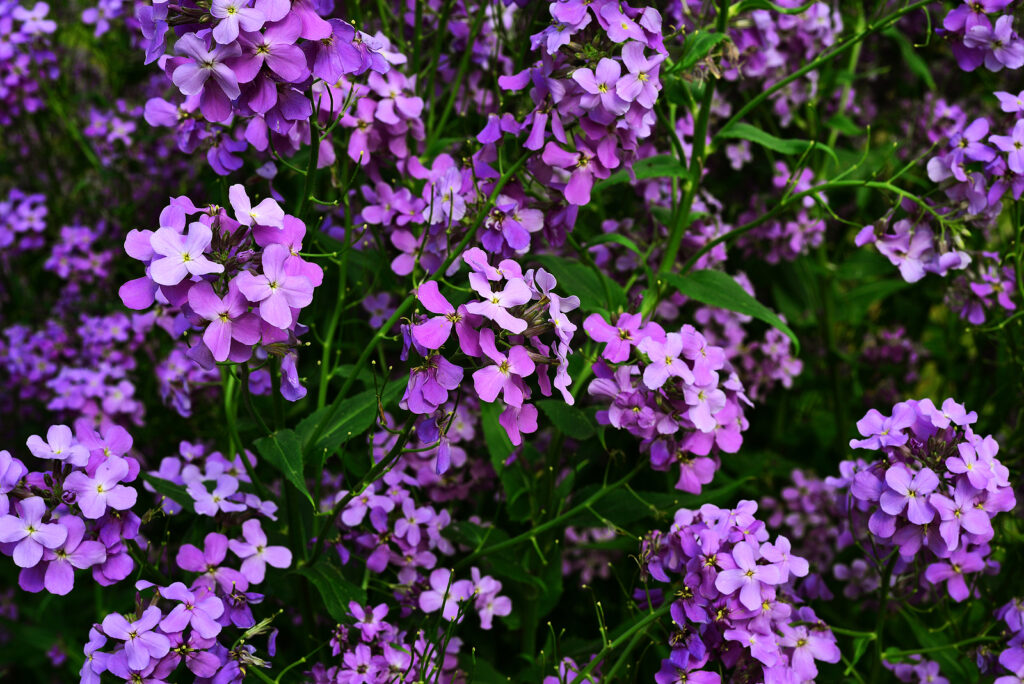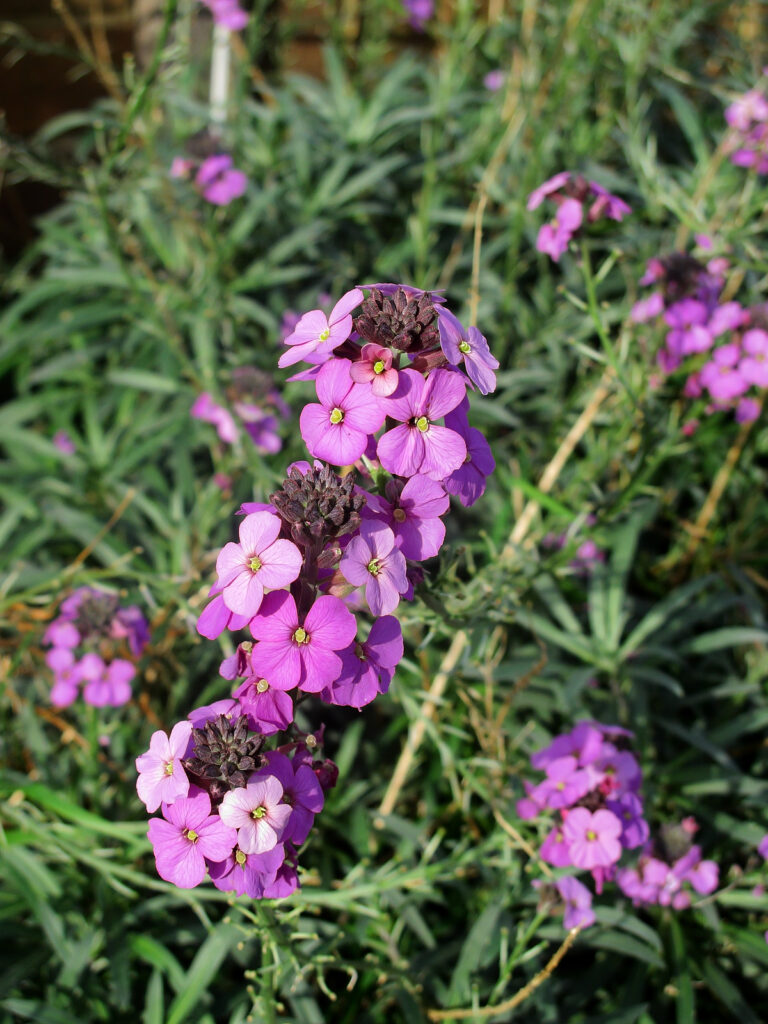Cheiranthus, commonly known as wallflowers, are perennial plants that are relatively easy to grow. Cherianthus bears showy, terminal spikes of bright, sweet fragrant flowers adding a pop of color to the garden. Cherianthus is a great cut flower than can be enjoyed indoors. It also attracts butterflies and pollinators to the garden.
Cherianthus are small to medium-sized plants with woody stems and narrow, lance-shaped leaves. The flowers are arranged in dense clusters at the top of the stem and come in a variety of colors, including shades of yellow, orange, pink, purple, and red. The flowers have four petals and a sweet, spicy fragrance.
Cherianthus plants are generally easy to care for and can bloom from early spring to late summer, depending on the variety. Wallflowers are commonly grown in garden borders, rock gardens, and containers. They prefer well-drained soil and full sun, and are known for their ability to attract butterflies and other pollinators to the garden.
Cherianthus are a genus of flowering plants that belong to the Brassicaceae family. These plants are native to Europe and Asia. Cherianthus can also be found under the botanical name Erysimum. See How to Grow Erysimum.

Get to know Cheiranthus
- Plant type: Perennial, often grown as biennials
- Growing zones and range: Zones 5-9
- Hardiness: Frost will end the season
- Height and width: 9 to 18 inches and wide
- Foliage: Slender stems and narrow, lance-shaped leaves
- Flowers: Small and fragrant, with four petals that come in a variety of colors including yellow, orange, pink, and purple
- Bloom time: Late spring and early summer
- Uses: Beds, borders, rock gardens, cut flowers
- Common name: Wallflower, Siberian wallflower
- Botanical name: Cherianthus
- Family name: Brassicaceae
- Origin: They are native to Europe, Asia, and North Africa.
Where to plant Cheiranthus
- Cheiranthus prefer full sun and well-drained soil. Cherianthus can also tolerate some shade, but will bloom more profusely in full sun.
- Plant Cheiranthus in a location where it will receive at least 6 to 8 hours of sunlight per day
- Cheiranthus prefer slightly alkaline to neutral soil. If your soil is too acidic, you can add lime to increase the pH level.
- Before planting Cherianthus, enrich the soil with compost or well-rotted manure to improve drainage and fertility.
When to plant Cheiranthus
- Sow Cherianthus seed directly into the garden bed in early spring, summer, or fall. Sow seeds in fall to grow Cherianthus as a biennial.
- Sow seeds indoors 6 to 8 weeks before the last expected frost; germination takes 5 to 7 days.
- Spring bloom: sow seeds directly in the gardwn in mid to late summer so that plants can winter over for early spring bloom.
- Cherianthus can be grown from seeds or seedlings.
Planting and spacing Cheiranthus
- Plant Cherianthus in the spring or fall, spacing them about 6 to 8 inches or more apart. Dig a hole that is slightly larger than the root ball of the plant and backfill with soil.
- If started from seed indoors, transplant seedlings when they are 2 to 3 inches tall. Pinch off the tip of the tamproot to encourage fibrous root growth and replant 6 to 8 inches apart.
- When plants are 4 inches tall, pinch off the stem tips to encourage multiple branching.

How to water and feed Cheiranthus
- Water your Cheiranthus regularly, especially during dry periods. Overwatering can leaves Cherianthus prone to root rot. Water at the base of the plant to avoid getting the foliage wet, which can lead to fungal diseases.
- Fertilize Cheiranthus in the spring with a balanced fertilizer to promote healthy growth and blooming. You can also top-dress them with compost or well-rotted manure to improve soil fertility.
- Feed Cherianthus with a balanced fertilizer every 4-6 weeks during the growing season to promote healthy growth and abundant flowering.
Cheiranthus care
- Remove faded Cheiranthus flowers regularly to encourage continuous blooming and to prevent the plant from going to seed prematurely. Trim back any leggy or overgrown stems to promote bushy growth.
- Mulch around Cheiranthus plants to help retain moisture in the soil and suppress weeds. This will also help protect their roots during colder months and heat during hot months.
- Deadhead spent flowers: Remove faded flowers regularly to encourage continuous blooming and prevent plants from going to seed prematurely.
- Trim back the plants after they finish blooming to promote new growth.
Cheiranthus pests and diseases
- Cheiranthus are relatively resistant to pests and diseases, but they can still be affected by aphids, caterpillars, slugs, snails, and powdery mildew. Keep an eye out for any signs of infestation and treat them promptly with insecticidal soap or neem oil.
- Treat any issues promptly to prevent them from spreading.
- Treat any infestations promptly with insecticidal soap or other appropriate measures.
Cheiranthus propagation
- Cherianthus can be propagted from seed or cuttings.
- To ensure reproduction of preferred characteristics, propagate Cherianthus from stem cuttings taken in early summer.
Cheiranthus varieties to grow
- Cherianthus allionii, alsco called Erysimum aspernum or Erysimum hietraciifolium, is commonly known as Siberian wallflower; varieties include ‘Early Wonder Mixed Colors.
- Cherianthus ‘Bowles Mauve’, see also Erysimum ‘Bowles Mauve’
- C. cheiri is commonly known as English wallflower; named varieties include ‘Blood Red’, ‘Cloth of Gold’, ‘Eastern Queen’ (salmon-red), ‘White Dame’, and ‘Fire King’ (orange-scarlet); mixed colors include ‘Bedding Mixed’ which grows to 18 inches tall and ‘Double Dwarf Mixed’ which stays below 15 inches.
Related articles:















